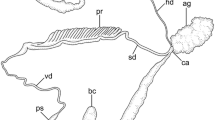Abstract
The normal male of Drosophila subobscura displays polymegaly, which is the presence of two sizes of spermatozoa in the same testis. It is still unknown whether both kinds of sperm are able to fertilize the egg. An indicator of normal functioning of Drosophila spermatozoa is the replacement of the somatic histones by sperm-specific arginine-rich nucleoproteins during spermiogenesis. The appearance of these arginine-rich nucleoproteins in the two kinds of sperm was investigated using the fluorescent dye sulfoflavine, which stains basic proteins at pH 8.
In the spherical nuclei of early spermatids of Drosophila subobscura the somatic histones fluoresced strongly, but fluorescence could not be detected in later stages when the spermatid nuclei were elongating. After elongation, however, the nuclei of both kinds of sperm, long and short, fluoresced brightly again, due to the presence of sperm-specific arginine-rich nucleoproteins. Half of the cysts of both types contained spermatid nuclei with aberrant fluorescent pattern including 5–9% of both cyst types which do not undergo histone transition at all.
These results indicate that both sperm types may be functional.
Similar content being viewed by others
References
Baccetti, B. & Afzelius, B. A., 1976. The biology of the sperm cell. Monographs in developmental biology Series, Ed. A. Wolsky. Karger, Basel-Müchen-Paris-London-New-York-Sydnev.
Beatty, R. A. & Burgoyne, P. S., 1971. Size classes of the head and flagellum of Drosophila spermatozoa. Cytogeneties 10: 177–189.
Beatty, R. A. & Sidhu, N. S., 1971. Polymegaly of spermatozoan length and its genetic control in Drosophila species. Proc. r. Soc. Edinb. B 71: 14–29.
Bloch, D. P., 1966. Cytochemistry of the histones. Protoplasmatologia 3. Chemistry and cytochemistry of nucleic acids and nuclear proteins, pp 1–56.
Bloch, D. P. & Brack, S. D., 1964. Evidence for the cytoplasmic synthesis of nuclear histone during spermatogenesis in the grasshopper Chortophaga viridifasciata. J. Cell Biol. 22: 327–340.
Bouvier, D. & Chevaillier, P., 1976. A correlation between histone acetylation and chromatin changes in spermatids of the locust (Locusta migratoria). Cytobiologic 12: 287–304.
Brock, W. A., Trostle, P. K. & Meistrich, M. L., 1980. Meiotic synthesis of testis histones in the rat. Proc. natn. Acad. Sci. U.S.A. 77: 371–375.
Das, C. C., Kaufmann, B. P. & Gay, H., 1964. Histone-protein transition in Drosophila melanogaster. Expl Cell Res. 35: 507–514.
Das, C. C., Kaufmann, B. P. & Gay, H., 1964. Autoradiographic evidence of synthesis of an arginine-rich histone during spermiogenesis in Drosophila melanogaster. Nature 204: 1008–1009.
Dubler-Hänggi, S., 1977. Spermatogenese von Drosophila subobscura bei Kontroll- und sex ratio-Tieren. Thesis, University of Zürich, Switzerland.
Fricdländer, M. & Gitay, H., 1972. The fate of the normal-anucleated spermatozoa in inseminated females of the silk worm Bombyx mori. J. Morph. 138: 121–130.
Friedländer, M. & Hauschteck-Jungen, E., 1982. Differential basic nucleoprotein kinetics in the two kinds of Lepidoptera spermatids: Nucleated (eupyrene) and anucleated (apyrene). Chromosoma 85: 387–398.
Hauschteck-Jungen, E. & Maurer, B., 1976. Sperm dysfunction in sex ratio males of Drosophila subobscura. Genetica 46: 459–477.
Hauschteck-Jungen, F. & Hartl, D. L., 1982. Defective histone transition during spermiogenesis in heterozygous segregation distorter males of Drosophila melanogaster. Genetics 101: 57–69.
Kaye, J. S., McMaster-Kaye, R. & Moss, S. B., 1978. Fractionation of cricket testis nuclei on gradients of colloidal silica for study of basic protein changes during spermiogenesis. Expl Cell Res. 117: 245–253.
Kettaneh, N. P. & Hartl, D. I., 1976. Histone transition during spermiogenesis is absent in segregation distorter males of Drosophila melanogaster. Science 93: 1020–1021.
Kettaneh, N. P. & Hartl, D. L., 1980. Ultrastructural analysis of spermiogenesis in segregation distorter males of Drosophila melanogaster: The homozygotes. Genetics 96: 665–683.
Leemann, U. & Ruch, F., 1972. Cytofluorometric determination of basic and total proteins with sulfaflavine. J. Histochem. Cytochem. 20: 659–671.
Meistrich, M. L., Reid, B. O. & Barcellona, W. J., 1976. Changes in sperm nuclei during spermiogenesis and epididymal maturation. Expl Cell Res. 99: 72–78.
Olivieri, G. & Olivieri, A., 1965. Autoradiographic study of nucleic acid synthesis during spermatogenesis in Drosophila melanogaster. Mutation Res. 2: 366–380.
Policansky, D., 1970. Three sperm sizes in D. pseudoobscura and D. persimilis. Drosoph. Inf. Serv. 45: 119.
Ruch, F., 1970. Principles and some applications of cytofluorometry. In: Introduction to quantitative cytochemistry II. (Wied, G. L. & Bahr, G. F., eds). Academic Press, New York-London.
Shoup, J. R., 1967. Spermiogenesis in wild type and in male sterility mutant of Drosophila melanogaster. J. Cell Biol. 32: 663–675.
Sidhu, N. S., 1963. Genetic effects on the spermatozoa of Drosophila. Ph.D. thesis, University of Edinburgh.
Sidhu, N. S., 1969. Length of the spermatozoan nucleus in a diallel cross of three strains of Drosophila subobscura. Indian J. Hered. 1: 1–4.
Tung, P. S., 1972. Radioautographic study of RNA and histone syntheses in the testicular cyst of Drosophila. Drosoph. Inf. Serv. 48: 124.
Tokuyasu, K. T., Peacock, W. J. & Hardy, R. W., 1972. Dynamics of spermiogenesis in Drosophila melanogaster. II Coiling process. Z. Zellforsch. mikrosk. Anat. 127: 492–525.
Vendrely, R. & Vendrely, C., 1966. Biochemistry of histones and protamines. Protoplasmatologia. V. Karyoplasma (Nucleus). 3. Chemistry and cytochemistry of nucleic acids and nuclear proteins. pp. 1–88.
Wu, R. S. & Bonner, W. M., 1981. Separation of basal histone synthesis from S-phase histone synthesis in dividing cells. Cell 27: 321–330.
Yanders, A. F. & Perras, J. P., 1960. Sperm length in four Drosophila species. Drosoph. Inf. Serv. 34: 112.
Author information
Authors and Affiliations
Rights and permissions
About this article
Cite this article
Hauschteck-Jungen, E., Rutz, G. Arginine-rich nucleoprotein transition occurs in the two size classes of spermatozoa of Drosophila subobscura males. Genetica 62, 25–32 (1983). https://doi.org/10.1007/BF00123306
Received:
Accepted:
Issue Date:
DOI: https://doi.org/10.1007/BF00123306




